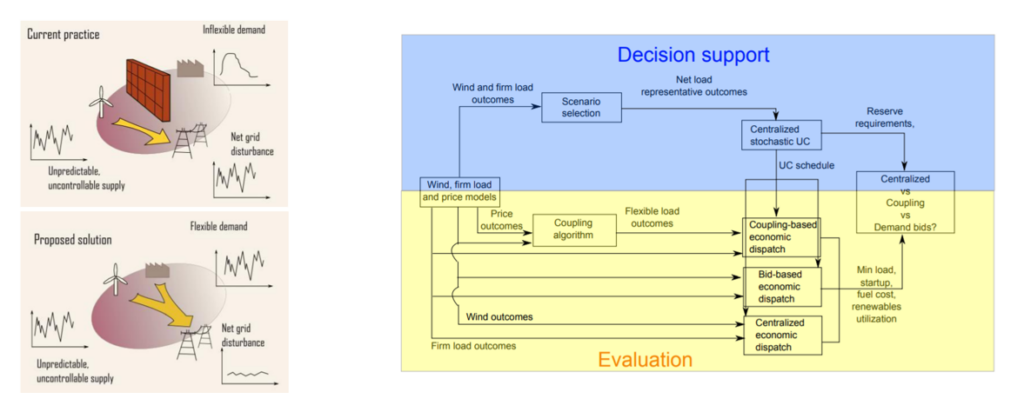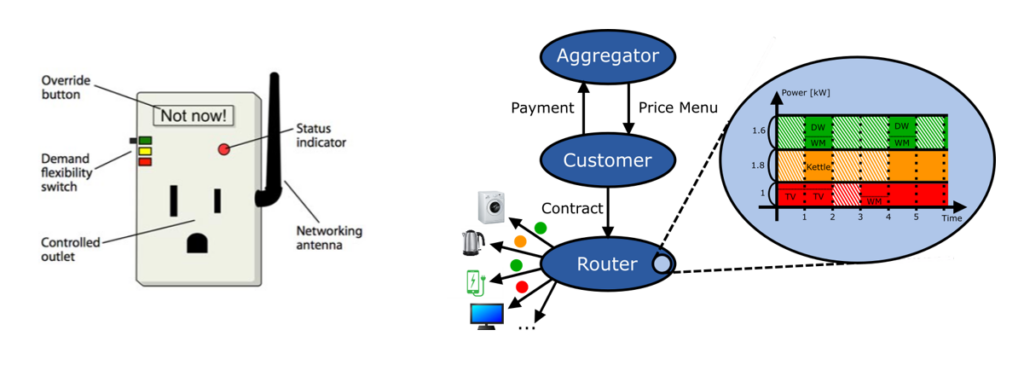Context: A significant portion of the electricity that we consume can be shifted in time with a relatively minor impact on our comfort. Consider, for example, dish washers, laundry, dryers, or in the future electric vehicle charging: some of the most energy-intensive devices in our homes also happen to be deferrable. This is a very suitable complement to renewable resources that are available in relatively unpredictable patterns (see left panel in the figure below).
Demand response paradigms: The evaluation of the system benefits of demand response is a challenging modeling exercise. These benefits, which amount to reduced operational cost and contributions of demand response to reserves, require coupling a model of consumer flexibility with a model of short-term system operations. Such a modeling framework is outlined in the right panel of the following figure. Various demand response aggregation paradigms can be envisioned, such as a centralized dispatch of demand response by system operators, or decentralized coupling of renewable resources with flexible loads through demand response aggregators.

Capacity and energy-based tariffs: The active engagement of demand response through real-time pricing is an ideal scenario, which however requires significant commitment from consumers. For certain consumer classes, such as residential consumers, the benefits of such active engagement may not justify the effort of active engagement. Alternative aggregator business models based on capacity charges (e.g. priority service pricing) or a mixture of volumetric and capacity charges (e.g. multi-level demand subscription) may present an alternative opportunity for engaging residential consumers with simple tariffs and an automation of device control at the level of the household.
An instantiation of such a scheme, which also in line with the business models of certain ongoing industrial initiatives, is presented in the following figure. The idea is that electricity service is differentiated by reliability, with higher reliability corresponding to higher price. Customers procure strips of power at different reliability levels, and “color tag” the devices in their homes (either manually or automatically through a home energy router) according to their desired priority (left panel of the figure below). When allocating devices to different reliability levels through these color tags, the residential customer is bound by its contract, so that the total capacity tagged under a specific color for a given time interval may not exceed the capacity procured under that color in the customer’s contract. The more flexible the customer, the cheaper the contract that they can enroll in, since this flexibility can be monetized by a demand response aggregator who can make this flexibility available in the wholesale electricity market.

Read more
Y. Mou, C. Gérard, A. Papavasiliou, P. Chevalier, Designing Menus for Multilevel Demand Subscription, Hawaii International Conference on System Sciences, under review
Y. Mou, A. Papavasiliou, P. Chevalier, A Bi-Level Optimization Formulation of Priority Service Pricing, IEEE Transactions on Power Systems, vol. 35, no. 4, pp. 2493-2505, July 2020
A. Papavasiliou, S. S. Oren, Large-Scale Integration of Deferrable Demand and Renewable Energy Sources, IEEE Transactions on Power Systems, vol. 29, no. 1, pp. 489-499, January 2014

